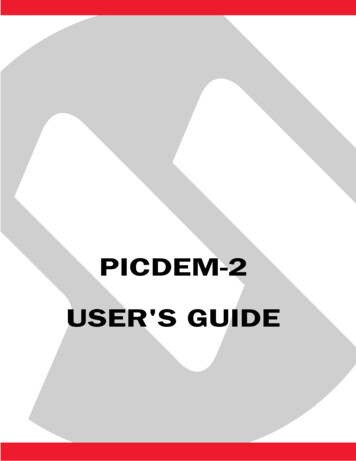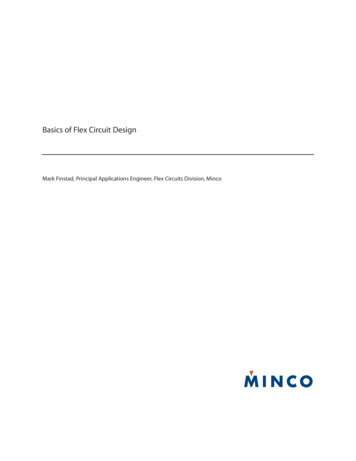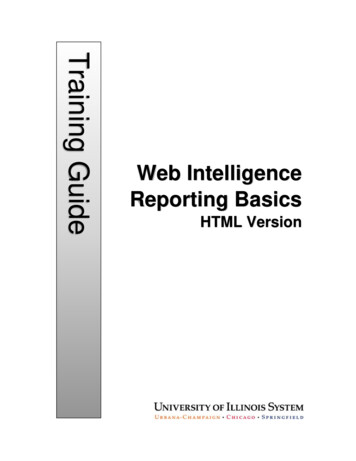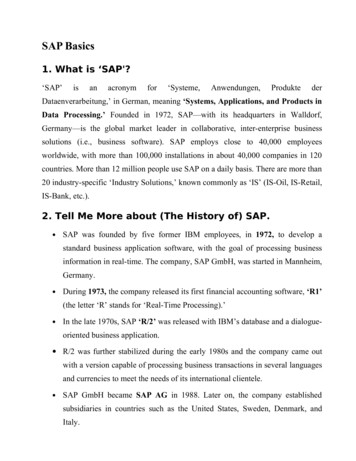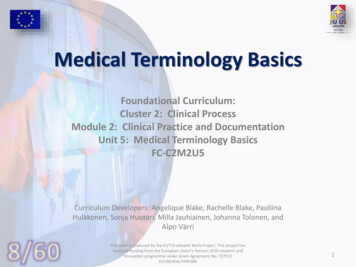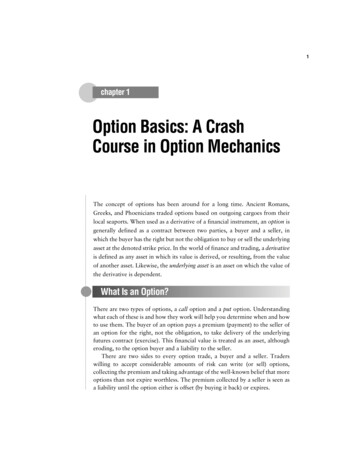
Transcription
OnlineICU GuidebookHomeICU BasicsIntensive Care TopicsVasopressorsMechanical VentilationProcedures CalcsCore ICUCore CCUHOMEWelcome to the online ICU Guidebook.The purpose of this website is to provide residents with quick online access to information that will helpduring your ICU/CCU rotations.How to use this document:ICU Basics: basic tips for surviving your rotation. ICU daily checklist.Intensive Care Topics: common admissions and useful algorithms.Vasopressors: a quick reference for use of common vasopressor agents.Mechanical ventilation: a quick reference for ventilators.Procedures Calculators: a collection of procedure tips, videos, notes, and useful calculators.CORE ICU Articles: Must read ICU articles.CORE CCU Articles: Must read CCU articles.Other important sites:Online Housestaff Survival GuideUIH Clinical Care GuidelinesNew-InnovationsAMION [cards]HOMEOnline ICU Guidebook
ICU Guidebook BasicsHomeICU BasicsIntensive Care TopicsVasopressorsMechanical VentilationProcedures CalcsCore ICUCore CCUBasicsOnline ICU GuidebookGeneralWelcome to your ICU Month(s). These are some general rules/guidelines to follow:Three L’s to NOT DO:Lie (especially parts of physical exam that you did not do)Be LazyBe LateThese are the habits to ICU success:Be OrganizedBe InvolvedBe EfficientBe ThoroughTake InitiativeTake Ownership of Your patientsDaily routine / Patient careProgress NotesHere is a checklist that should be followed for every ICU patient:Organ based is generally the mostDaily Checklistthorough. For CCU, include cardiacEvery day each person should have the following addressed:studies in your note and cardiac systems1. Code Statusin you’re A/P:2. Sedation (held in am, when stopping, etc.)1. CAD3. GI Prophylaxis (most important when intubated)2. CHF4. DVT Prophylaxis3. EP5. Fluid, electrolytes, nutrition4. HTN6. Disposition5. LipidsOther daily tasks to always keep in mind:Monitor I/O on EVERY PATIENT with 24h totalsKnow their IV access including dates central lines havebeen placedDuration of abx useDuration of steroid use for shock patientsFor Mechanically Ventilated Patients, always know the following:Date IntubatedSize of TubeVent Settings (mode/rate/volume/pressure/PEEP/FiO2)Peak/Plateau Pressure
OnlineICU GuidebookHomeVasopressorsMechanical VentilationICU TopicsShock algorithmSeptic shockCardiogenic shockPulmIntensive Care TopicsShockICU BasicsCore CCUHypertensive crisisHeart failureHypothermia protocolAntimicrobials in the ICUICU TopicsOnline ICU GuidebookEndoVancomycin dosingDKAHHSARDSCOPDAsthmaOther NeuroCore ICUIDProcedures CalcsCVHypovolemic shockRespiratory distressSeizuresBrain DeathSedationAcid-base reviewDecision Making CapacityDeath Pronouncement
ICU Guidebook Intensive Care Topics ShockWhen evaluating a patient with hypotension, always think of the following algorithm.Think of life-threatening causes and immediately rule them out. Here are somepointers: ECG to r/o AMI as a cause of cardiogenic shock CBC to r/o acute blood loss Infectious workup if sepsis is suspectedHypotensionHomeQuick Links Surviving sepsis GuidelinesAntimicrobialsSepsisCardiogenic ShockHypovolemic ShockICU BasicsIntensive Care TopicsDecreased pulse pressureCool extremitiesPoor cap refillWide pulse pressureWarm extremitiesGood cap refillSIRS criteria?Suspected infxn?VasopressorsFluid OverloadHypovolemicMechanical VentilationProcedures CalcsCardiogenic ShockCore ICUCore CCUICU TopicsOnline ICU GuidebookHypovolemic ShockSeptic shock
ICU Guidebook Intensive Care Topics SepsisWhen evaluating a patient with hypotension, immediately try to assess whether yoususpect sepsis, and where in the sepsis spectrum the patient falls. Does he meet SIRScriteria? Does he have a known or suspected source of infection?Once you clarify this and you have ruled out other causes of shock, follow thealgorithms below from the surviving sepsis campaign and initate EGDT. The originalarticles can be found in the CORE ICU folder.HomeICU BasicsIntensive Care TopicsVasopressorsMechanical VentilationProcedures CalcsCore ICUCore CCUICU TopicsOnline ICU GuidebookQuick Links Surviving sepsis GuidelinesAntimicrobialsSepsis calculatorShockCardiogenic ShockHypovolemic Shock
ICU Guidebook Intensive Care Topics Cardiogenic shockQuick Links Suspected Cardiogenic Shock- SBP 90- Signs of Low Cardiac Output: oliguria,pulmonary edema, poor mental statusHomeInitial evaluation and Rapid Stabilization- Immediate ECG- Look for evidence of AMI: ST elevations, newLBBB, suspected -posterior MI- Supplemental O2- BP Support: Dopamine, Norepinephrine,DobutamineICU BasicsIntensive Care TopicsYesVasopressorsSigns of ischemia on EKG?Immediate ReperfusionMechanical VentilationProcedures CalcsCore ICUCore CCUICU TopicsOnline ICU GuidebookContinue medicalmanagement and BPsupport withinotropes/pressorsLV assist device, HearttransplantNoImmediate TTE- Evaluate LV/RV function- r/o mechanical causes:acute valvular issues,papillary muscle rupture,VSD, free wall ruptureHeart FailureACS UIH GuidelinesADHF UIH GuidelinesShockSeptic shockHypovolemic Shock
ICU Guidebook Intensive Care Topics Respiratory distressQuick Links HomeICU BasicsIntensive Care TopicsVasopressorsMechanical VentilationProcedures CalcsCore ICUCore CCUICU TopicsOnline ICU GuidebookConcerning levels from an ABG & VS that maysuggest future need for intubation:* PaO2/FiO2 300-200* Increased PaCO2 tachypnea* RR 30-35* PaO2 50 on 50% or greater FiO2* PaCO2 55 w/ nL lung fxn (I.e no COPD, fibroticlung dz)* pH 7.3ABG CalculatorA-a gradientWells criteria for PEDecision to IntubateAsthmaCOPD
ICU Guidebook Intensive Care Topics ARDSINCLUSION CRITERIA: Acute onset of1. PaO2/FiO2 300 (corrected for altitude)2. Bilateral (patchy, diffuse, or homogeneous) infiltrates consistent withpulmonary edema3. No clinical evidence of left atrial hypertensionHomeICU BasicsIntensive Care TopicsVasopressorsMechanical VentilationProcedures CalcsCore ICUCore CCUICU TopicsOnline ICU GuidebookVENTILATOR SETUP AND ADJUSTMENT1. Calculate predicted body weight (PBW)Males 50 2.3 [height (inches) - 60]Females 45.5 2.3 [height (inches) -60]2. Select any ventilator mode3. Set ventilator settings to achieve initial VT 8 ml/kg PBW4. Reduce VT by 1 ml/kg at intervals 2 hours until VT 6ml/kg PBW.5. Set initial rate to approximate baseline minute ventilation (not 35bpm).6. Adjust VT and RR to achieve pH and plateau pressure goals belowOXYGENATION GOAL: PaO2 55-80 mmHg or SpO2 88-95%Use a minimum PEEP of 5 cm H2O. Consider use of incremental FiO2/PEEPcombinations such as shown below (not required) to achieve goal.PLATEAU PRESSURE GOAL: 30 cm H2OCheck Pplat (0.5 second inspiratory pause), at least q 4h and after eachchange in PEEP or VT.If Pplat 30 cm H2O: decrease VT by 1ml/kg steps (minimum 4 ml/kg).If Pplat 25 cm H2O and VT 6 ml/kg, increase VT by 1 ml/kg until Pplat 25cm H2O or VT 6 ml/kg.If Pplat 30 and breath stacking or dys-synchrony occurs: may increase VT in1ml/kg increments to 7 or 8 ml/kg if Pplat remains 30 cm H2O.pH GOAL: 7.30-7.45Acidosis Management: (pH 7.30)If pH 7.15-7.30: Increase RR until pH 7.30 or PaCO2 25(Maximum set RR 35).If pH 7.15: Increase RR to 35.If pH remains 7.15, VT may be increased in 1 ml/kg steps until pH 7.15 (Pplat target of 30 may be exceeded).May give NaHCO3Alkalosis Management: (pH 7.45) Decrease vent rate if possible.Quick Links ABG CalculatorA-a gradientWells criteria for PEARDSnet protocolAsthmaCOPD
ICU Guidebook Intensive Care Topics COPDYour initial evaluation of COPD should include the following:- History, Physical, Basic labs- Chest XR- Arterial blood gas analysisHomeICU BasicsIntensive Care TopicsVasopressorsMechanical VentilationProcedures CalcsQuick Links Once your clinical impression of COPD is confirmed, you can initiate yourtreatment:- Bronchodilator therapy- Corticosteroids- Supplemental O2 if needed- AntimicrobialsABG CalculatorA-a gradientWells criteria for PEDecision to IntubateAsthmaCOPDIn this section we will discuss COPD topics specific for the ICU.Antimicrobials for COPD ExacerbationsStep 1 Assessment of antibiotic indications for COPD Three cardinal symptoms Increased dyspnea, increased sputum volume, increase sputum purulence Require mechanical ventilationStep 2 Antibiotic Choices: High Risk: Levofloxacin Low Risk: Azithromycin, DoxycyclineBiPAPStep 3 Thorough Eval for Other Causes of ExacerbationInitiate BiPAP/noninvasive Drugsventilation in s setting where ETT Arrythmias (Afib)can be performed if needed Coronary Ischemia Pneumothorax Viral Infection Pulmonary embolismContinue BiPAPand serial reassessmentsYes?Improvement?No?Core ICUNo?Core CCUMechanical Ventilation in COPD ExacerbationsICU TopicsOnline ICU GuidebookAre there any reasons why the patient cannot toleratenoninvasive mechanical ventilation? Acute respiratory failure Agitation or altered mental status Hemodynamic instability Excessive secretions Unable to provide proper mask fittingYes?Endotracheal IntubationInitiate BiPAP/noninvasive ventilation ins setting where ETT can be performed ifneeded
ICU Guidebook Intensive Care Topics AsthmaQuick LinksHomeICU BasicsIntensive Care TopicsVasopressorsMechanical VentilationProcedures CalcsCore ICUCore CCUICU TopicsOnline ICU Guidebook ABG CalculatorA-a gradientWells criteria for PEDecision to IntubateCOPDUIH Asthma Guidelines
ICU Guidebook Intensive Care Topics HTN CrisisWhen treating a HTN emergency, always consider invasive BP monitoring for more accurate vital signs.When evaluation a HTN crisis, evaluate where in the disease spectrum the patient falls by followingthe algorithm below. Choose the appropriate medication based on the clinical scenario.SBP 180DBP 120HomeTarget Organ Damage? ACS/MI/UA Dissecting aortic aneurysm LV Failure w/ pulmonary edema Pulmonary edema w/ respiratory failure RBC in UA Hypertensive encephalopathy Intracerbral hemorrhage Microangiopathic haemolytic anemia Severe pre-eclampsia / eclampsia / HELLP Acute post-operative hypertension (190/100)ICU BasicsIntensive Care TopicsVasopressorsMechanical VentilationProcedures CalcsCore ICUCore CCUICU TopicsOnline ICU GuidebookYESHypertensive EmergencyInitially reduce MAP by 25% over 1hourReduce DBP by 10-15% or to 110mmHg over 30-60 minTarget reduce to less than 160 / 110-100 within thenext 2-6 hours (Aortic Dissection: Rapidly reduce (10min) to less than 120/80, include beta-blocker),Ischemic stroke Tx if 220/140-120)Quick Links Heart FailureACS UIH GuidelinesADHF UIH GuidelinesTIMI ScoreECG GuideIV Med Infusion SheetAntiHTN MedicationsNOHypertensive UrgencyUse oral medication to decrease blood pressure of the next 24-48 hoursConsider short-acting oral agents Captopril 12.5-25 mg q8hr Clonidine 0.1- 0.3 mg q1hr (0.6 mg max, Duration 12hr) Avoid SL Nifedipine (IR)Restart home medication?Convert to long-term anti-hypertensive as per guidelines and compellingindications
ICU Guidebook Intensive Care Topics Heart FailureAlways keep in mind the table below, a simplified version of the Forrester Classification. This helps youstratify your patient with Acute Decompensated Heart Failure and tailor therapy based on where inthe disease spectrum they are.HomeICU BasicsIntensive Care TopicsVasopressorsMechanical VentilationProcedures CalcsCore ICUCore CCUICU TopicsOnline ICU GuidebookWarm & DryOutpatient treatmentWarm & WetDiuretics VasodilatorsPulmonary edemaCold & DryInotropesCold & WetInotropes, IABP, etcCardiogenic ShockQuick Links HTN CrisisACS UIH GuidelinesADHF UIH GuidelinesTIMI ScoreECG GuideIV Med Infusion Sheet
ICU Guidebook Intensive Care Topics DKADKA usually presents with serum glucose 250 mg/dl, arterial pH 7.3, serum bicarbonate 18 mEq/l,and moderate ketonuria ketonemia.Follow the algorithm below for proper management.HomeICU BasicsIntensive Care TopicsVasopressorsMechanical VentilationProcedures CalcsCore ICUCore CCUICU TopicsOnline ICU GuidebookQuick Links Na CorrectionAnion Gap CalculatorABG CalculatorAcid-base reviewHHS/HONK
ICU Guidebook Intensive Care Topics HHS/HONKHHS / HONK usually presents with serum glucose 600 mg/dl, arterial pH 7.3, serum bicarbonate 15mEq/l, and minimal ketonuria and ketonemia.Follow the algorithm below for proper management.HomeICU BasicsIntensive Care TopicsVasopressorsMechanical VentilationProcedures CalcsCore ICUCore CCUICU TopicsOnline ICU GuidebookQuick Links Na CorrectionAnion Gap CalculatorABG CalculatorAcid-base reviewDKA
ICU Guidebook Intensive Care Topics AntimicrobialsQuick empiric choices:Meninges – Ceftriaxone/Vancomycin, consider Ampicillin Aspiration – Cover for anaerobes,clindamycinGU – FQ, bactrim, amp/gent Skin – think community acquired MRSA: clindamycin, vancomycinGI – FQ, metronidazole, pip/tazo Lines – VancomycinHomeICU BasicsIntensive Care TopicsVasopressorsMechanical VentilationProcedures CalcsCore ICUCore CCUICU TopicsOnline ICU GuidebookAntibiotics for COPD Exacerbations (www.goldcopd.org)Step 1 Assessment of antibiotic indications for COPD· Three cardinal symptoms· Increased dyspnea, increased sputum volume, increase sputum purulence· Require mechanical ventilationStep 2 Antibiotic Choices:· High Risk: Levofloxacin· Low Risk: Azithromycin, DoxycyclineStep 3 Thorough Eval for Other Causes of Exacerbation Drugs Arrhythmias (Afib) Coronary Ischemia Pneumothorax Viral Infection Pulmonary embolismManagement of Fungal Infections (www.idsociety.org)Major risk factors for fungemia· Recent use of broad-spectrum antibiotics (allow fungal overgrowth)· Colonization of fungus in normal sterile location (ie-candiuria*)Minor risk factors for fungemia· Central venous catheter (TPN, chronic infusion therapy, hemodialysis)· Multiple abdominal surgeries· Critically ill patient· Immunosuppression, steroid useCommon Yeast Pathogens· Candida Albicans –Pathogen in 70-80% of fungemias, highly susceptible tofluconazole· Non-albicans species· C. glbrata – Dose-dependent susceptibility to fluconazole· C. krusei – Must use micafungin, voriconazole to treat· C. parapsilosis – Resistant to micafungin and other echinocandinsTreatment options for disseminated candidiasis· Hemodynamically stable patient: Fluconazole 6 mg/kg (400-800 mg) IV/PO q24(renal dose CrCL 50)· Hemodynamically unstable patients: Micafungin 100 mg IV q24 (or otherechinocandin)· Ophthalmic examination to rule out endophthalmitis if documented fungemia*Current IDSA guidelines recommend against the treatment of asymptomaticfungal cystitis unless high risk for developing disseminated candidiasis(neutropenic, urologic procedure)Quick Links UIH Abx GuidelinesUIH PNA GuidelinesUIH VAP GuidelinesVancomycin dosingDouble coverage of Gram Negative OrganismsRationale: Utilizing two different antimicrobial classes willincrease the likelihood of active antimicrobial therapy incritically ill patients. Should only be used for empirical therapy.Discontinue after microbiological susceptibilities are reported.Patients to consider double coverage (Clinicians should beselective in application!)· Patients with febrile neutropenia (follow current U of I hospitalguidelines)· Patients with little physiologic reserve· Severe sepsis and septic shock· ARDS from infections cause· Patient with significant exposure to anti-pseudomonal betalactam agents· Patients with late onset ( 14 days) nosocomial infections· MDR organisms: Psuedomonas, Acinetobacter, KPC KlebsiellapneumoniaeHow to double cover Gram-negative· Aminoglycosides (Amikacin, Gentamicin, Tobramycin) arepreferred over quinolones· A single dose of an aminoglycoside has not been shown toincrease the risk of AKI in septic shock patients· Quinolones add little additional coverage to anti-pseudomonalbeta-lactam agents (Micek et al. Antimicrob Agents Chemother.2010)Duration of treatment (Chastre. JAMA. 2003)An 8 day course was shown to be non-inferior to an 15 day course(mortality)There was more relapse with a short course in patients withPsuedomonal/Acinetobacter pneumonia when treated with a shortcourseConsider 15 day course in patients with:MDR (High MIC) Psueomonas or Acinetobacter pneumoniaPatients with slow clinical response ( 4 days)Patients with severe hypoxia
ICU Guidebook Intensive Care Topics VancomycinHow to order Vancomycin- Check your sources, confirm the medication is indicated- Check table below for appropriate/inappropriate uses- initial dose is based on actual body weight, subsequent doses based on blood levels- Adult dose calculation:initial dose 15mg/kg based on total body weightdosing interval based on CrCl: 80 Q12h, 40-79 Q24h, 25-39 Q48h, 25 15 mg/kg x 1dose (see III E)HomeICU BasicsIntensive Care TopicsVasopressorsMechanical VentilationProcedures CalcsCore ICUCore CCUICU TopicsOnline ICU GuidebookPharmacokinetic level monitoring- Obtain trough concentration (30 minutes priorto infusion) before 4th consecutive dose- Adjust dose to obtain goal trough concentrationof 10 - 20 mcg/mL- Trough concentration 15 - 20 mcg/mL isrecommended for bacteremia, endocarditis,osteomyelitis, meningitis and hospital acquiredpneumonia caused by Staphylococcus aureus toimprove clinical outcomeQuick Links AntimicrobialsUIH Abx GuidelinesUIH PNA GuidelinesUIH VAP GuidelinesUIH Vanc GuidelinesFrequency of vancomycin trough concentrationmonitoring:1. For patients receiving 5 days of vancomycinshould have least one steady-state troughconcentration obtained. Frequent monitoring(more than single trough concentration before 4thdose) for 5 days or for lower intensity dosing(target trough vancomycin concentration 15mcg/mL) is not recommended.2. For patients with stable renal function withgoal trough concentration 15 - 20 mcg/mL,monitor vancomycin trough concentration onceweekly for duration of therapy.3. For hemodynamically unstable patients whengoal trough concentration is 15 - 20 mcg/mL,more frequent than once weekly vancomycintrough concentration is recommended.Frequency of monitoring should be guided byclinical judgement.For patients with renal failure,follow levels, and re-dose for concentrations 15mcg/mLFor more information of Vancomycin dosing, check micromedx and/or UIC Clinical Care guidelines for Vancomycin use
ICU Guidebook Intensive Care Topics SeizuresInitially: stay calm, put pt in lateral decubitus position, suctioning to bedside, pad bed rails andprevent injury, ABCs – oxygen, protect airway, get vitals incl. tempAsk RN to call your seniorCauses: infection, metabolic (incl. Hypoglycemia), stroke, structural, trauma, neoplastic, iatrogenic,delirium tremensHomeICU BasicsIntensive Care TopicsLabs: accucheck; clin chem., Ca, mag, phos; also consider ABG, urine tox, serum tox, UA, EtOHlevel, drug levels; (can also consider prolactin level after seizure)If seizure is over: assess pt, labs, meds, diagnoses, consider head CT; treat the underlying causeManagement-airway: oxygen, ready to intubate-thiamine 100mg IV push, then 1amp D50 IV push-lorazepam 2-4mg IV/IM or diazepam at 2mg/min IV (up to 20mg) (whichever is available)(have ambu bag available b/c diazepam can cause resp depression)-phenytoin can be started in 2nd IV line; loading dose 18mg/kg (caution hypotension, arrhythmias)in IV until controlled; check lytesStatus epilepticus if 5min or 2 seizures with incomplete recovery àinvolve ICU, neuro, anesthesiaVasopressorsMechanical VentilationStatus EpilepticusSeizure 5m or multiple continuedseizures w/o return to baseline betweenseizuresLorazepam2-4mg IVPRate at 2mg/minProcedures CalcsICU TopicsOnline ICU GuidebookLorazepam0.1mg/kg IV, can continue at2mg/min or diazepam0.15mg/kgNeurology consultCore ICUCore CCUSz1) Phenobarbital 20mg/kg IV loadAdditional 10mg/kg if seizurescontinueRate at 50-100mg/minOther agents:2) Propofol 3-5mg/kg load, then 1-15 mg/kg/hr3) Midazolam 0.2mg/kg l
Severe pre-eclampsia / eclampsia / HELLP Acute post-operative hypertension (190/100) YES NO Hypertensive Emergency Initially reduce MAP by 25% over 1 hour Reduce DBP by 10-15% or to 110 mmHg over 30-60 min Target reduce to less than 160 / 110-100 within
